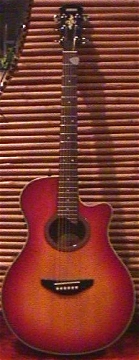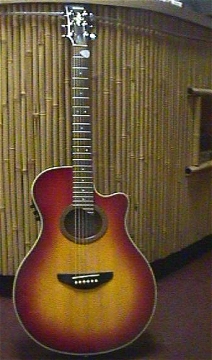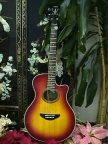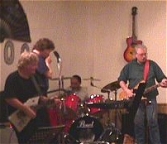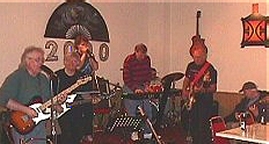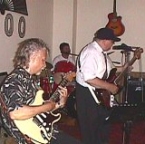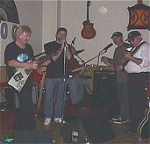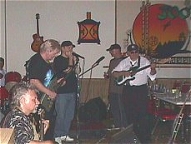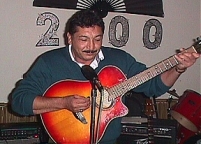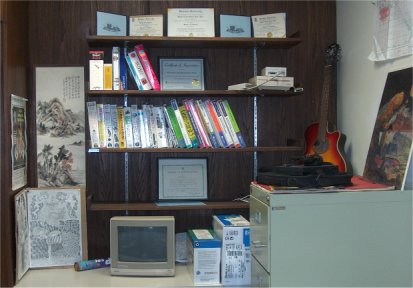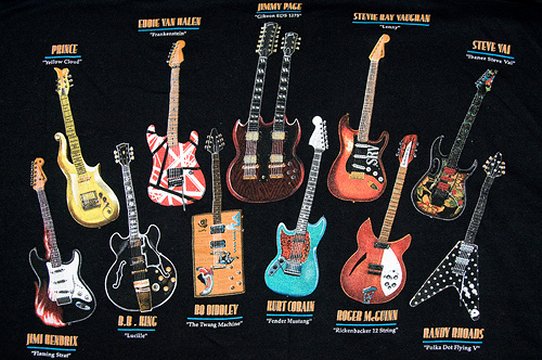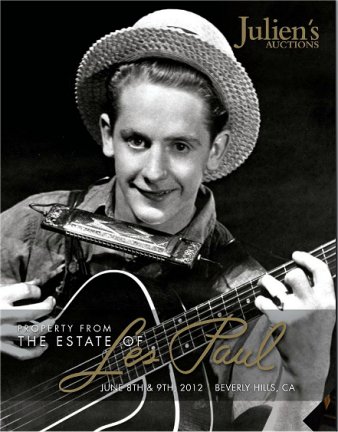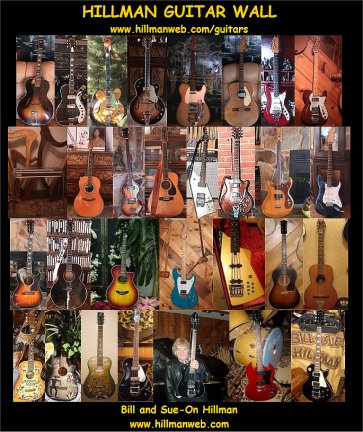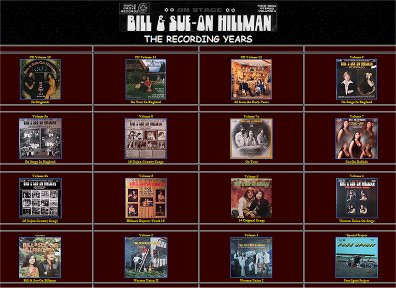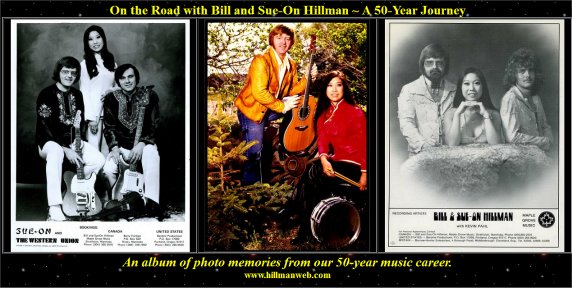Whose Guitar?
Lucille:
B. B. King. Interesting note: B.B. is short for Blues Boy (his nickname
when he was a DJ in the 40s). He named the guitar after he played a show
in a juke joint that caught fire and he ran in and grabbed the guitar.
He reflected on how foolish that was and he decided only a man in love
would act that way so he named the guitar after a woman.
Stratocaster #0001:
David Gilmour. This is NOT the first Stratocaster ever produced but
it was made in June 1954. It has a special paint job (it has a gold finish)
and Gilmour suspects it was a custom shop job with the special numbering
included. He said it is the kind of guitar that separates the players from
the wannabes and will never be sold.
Muddywood:
Billy Gibbons. Billy had this guitar built after a trip to Muddy Waters'
birthplace. He was allowed to take a board from the porch and had Rich
Rayborn build it. It features a recreation of the Mississippi River on
its body and neck. NOTE: Billy was Jimi Hendrix' favorite guitarist.
The Beast Stratocaster:
Dick Dale. The "King of the Surf Guitar" has played the guitar since
1961. He used to change the paint on it every few months to fool imitators.
It is now painted "glitter gold" and has his karate dojo sticker permanently
attached.
Space Bass:
Bootsy Collins. The bass was created by Larry Pless for Bootsy. It
was first seen on the 1976 cover of "Stretching Out". It was once stolen
in Chicago and was returned to Bootsy a year later because the thief couldn't
pawn it anywhere. Everyone knew who the real owner was.
Micawber:
Keith Richards. Supposedly named after a character in Charles Dickens’
book David Copperfield, Micawber has been Keith’s main guitar since Exile
on Main Street. Keith says: "There's no reason for my guitar being called
Micawber, apart from the fact that it's such an unlikely name. When I scream
for Micawber everyone knows what I'm talking about."
Jag-Stang
Kurt Cobain's. According to the late Nirvana frontman Kurt Cobain,
he designed his own guitar by taking Polaroids of a Fender Jaguar and a
Fender Mustang and cutting them to fit together. Fender began producing
the guitar after Cobain's death, and Courtney Love gave her husband's powder
blue prototype to R.E.M.'s Peter Buck.
Lucy:
George Harrison dubbed “Lucy” in honor of red-headed comedian Lucille
Ball, this cherry-hued ’57 Les Paul was given to George Harrison by Eric
Clapton in 1968. As a favor to George, Clapton played the instrument during
the recording of “While My Guitar Gently Weeps.” In the ‘70s, the legendary
guitar was stolen from Harrison’s home and ended up in the hands of a Mexican
musician who purchased Lucy from a music shop in California before returning
to his native country. However, Harrison was able to get his beloved guitar
back by trading a ’58 Les Paul and a bass to the musician in exchange for
Lucy, which he owned until his death in 2001.
Flying V and Whammy
Lonnie Mack: A pioneer in rock guitar soloing, Mack is said to have
given the tremolo bar its nickname – the "whammy" bar – after the title
of one of his instrumental hits, "Wham!" In 1958 Mack bought one of the
first Gibson Flying Vs off the production line, and it became his signature
guitar. Of native American descent, Mack has said he liked the guitar's
arrowlike shape.
Lenny:
Stevie Ray Vaughan, in 1980, came across this 1965 Fender Stratocaster
in a pawn shop in Austin, Texas, and instantly fell in love with the vintage
instrument. Unfortunately, back then he didn’t have the $350 asking price.
However, Stevie’s wife, Lenora “Lenny” Vaughan, rounded up $50 from seven
of their closest friends and bought the guitar for the Double Trouble front
man’s 26th birthday. Overwhelmed with emotion, Vaughan stayed up late that
night writing a song. The next morning, Lenora woke up to Stevie playing
the newly penned instrumental, “Lenny” for her.
Trigger:
Willie Nelson, in 1969, sent one of his banged-up guitars to a repair
shop in Nashville. The owner told him he couldn’t fix it but he had a Martin
for sale that he thought Willie might like. Nelson bought the N-20 for
$750 over the phone, sight unseen. After its delivery, he immediately fell
in love with the guitar, naming it “Trigger” after Roy Rodgers’ trusty
horse. Willie played the Martin so much over the years that he wore a large
hole in the top. However, the country star came to appreciate the unique
sound so much that he refused to have it repaired.
Old Black:
Most of Neil Young's electric guitar tracks have been recorded on "Old
Black," the guitarist's 1953 Gibson Les Paul Goldtop, which he traded from
Jim Messina back in 1969. Old Black, which got its name due to the fact
that it began life as a goldtop but was later the recipient of an amateur
black paint job, has been a headache for Young’s guitar tech, Larry Cragg.
The guitar has undergone numerous modifications and has endured plenty
of wear and tear over the years. The old Gibson frequently goes out of
tune and Young refuses to re-fret the fingerboard -- but when the stars
align, Old Black can still produce one of the most distinct sounds in the
music industry. “It's a demonic instrument. Old Black doesn't sound like
any other guitar," Cragg once said.
Cloud:
Prince. Made famous in the movie Purple Rain, Prince’s voluptuously
curvy custom-built "Cloud" guitar was designed by a local Minneapolis luthier
and reproduced by Schecter guitars.
Miss Pearly Gates:
Billy Gibbons. The ZZ Top guitarist is known for his big beard and
an even bigger guitar collection. However, the ax that has always held
a place in his heart is his coveted 1959 Les Paul. As the story goes, ZZ
Top gave their old 1930s Packard to a friend, Renee Thomas, to drive to
L.A. for a movie audition. After landing the role, Renee and the band jokingly
called the Packard “Pearly Gates” because they figured it must have had
divine powers. Renee ended up selling the car and wiring the money to Gibbons
on the very day he received a called about a ’59 Sunburst Les Paul that
was found under the bed of a man who had recently passed away. The guitarist
ended up loving the Gibson so much that he purchased it that day and dubbed
it “Miss Pearly Gates.”
Woodstock Strat:
Jimi Hendrix, in his short lifetime, was able to singlehandedly change
the sound of rock through his innovative guitar style and inexplicable
raw talent. An intense performer, Hendrix was known to “sacrifice” his
guitars by lighting them on fire. Fortunately, the 1968, the Stratocaster
he played during his legendary rendition of the “Star-Spangled Banner”
at Woodstock was spared this fiery fate. After Jimi’s death in 1970, the
guitar was put into storage until it was sold at auction to Microsoft co-founder
Paul Allen for $1.3 million.
Tiger:
Jerry Garcia. The late Grateful Dead bandleader played his guitar of
choice, "Tiger," over ten years beginning in 1979. Built by Sonoma County
luthier Doug Irwin, the heavy guitar (over 13 lbs.) comprises a "hippie
sandwich" of several layers of wood laminated together. Tiger's successor,
another Irwin guitar called Rosebud, was in need of repair in July 1995,
so Garcia played Tiger during the concert that would be his last.
Blackie:
Eric Clapton. In 1970, while visiting a music shop in Nashville, Clapton
came across a rack of old Fenders. He ended up purchasing six of them at
$100 apiece. Once he returned to England, he gifted three of the guitars
to fellow rockers George Harrison, Pete Townshend, and Steve Winwood, and
kept the rest for himself. Clapton decided to experiment by seeing if he
could assemble a “Super Strat” out of the best parts from each vintage
guitar. The end result was the legendary “Blackie” Stratocaster, named
after the guitar’s black finish.
Red Special:
Brian May. The Red Special is an electric guitar owned by Queen guitarist
Brian May and custom-built by May and his father. The Red Special is also
sometimes named in reviews as the Fireplace or the Old Lady, both nicknames
used by May when referring to the guitar. May has used it on Queen albums
and in live performances since the late 1960s. The name Red Special came
from the reddish-brown colour the guitar attained after being stained and
painted with numerous layers of Rustins' plastic coating. The name Fireplace
is a reference to the fact that the wood used to make the neck came from
a fireplace mantel. Brian and his father built this guitar from a 200-year-old
mantlepiece. Brian believes the wood is what gives him his famous sustain.
Lucy:
Albert King. King's first instrument was a diddley bow. Next, he built
himself a cigar box guitar, before buying a Guild acoustic. The instrument
he is usually associated with is a 1958 Gibson Flying V, "Lucy." He retired
Lucy in 1974 and began using a Flying V built by Dan Erlewine, and after
1980 also one built by Radley Prokopow.
The Frankenstein" Strat:
Eddie Van Halen. Musicians have long debated whether a Fender or Gibson
deserves to be called the best guitar in the world. Van Halen front man
Eddie Van Halen simply combined the two to create his legendary Frankenstrat
guitar. In the 1970s, Van Halen was able to buy the ash body for $50 because
there was a large knot in the wood. He then found a maple neck for the
guitar for $80, bringing the grand total of his prized ax to a whopping
$130. Eddie then utilized everything at his disposal, including bicycle
paint, masking tape and wax to give the Frankenstrat its unique look. The
crafty guitarist even cut up an old vinyl record to serve as a pickguard.
No. 1:
Stevie Ray Vaughn. This was Vaughn's main instrument that had to be
rebuilt often. He was very hard on his instruments (if you ever had the
priviledge of seeing him live you know what I'm talking about). He also
used such thick gauge strings that his fingers would get cut up and he'd
put superglue on the tips to keep playing! It was buried with him after
his tragic helicopter crash.
Cigar Box
Bo Diddley. The late Bo Diddley fashioned homemade guitars from cigar
boxes, an old folk tradition that gave his signature instrument its distinctive
rectangular shape. Before Gretsch began producing Diddley's guitars, he
built two dozen or more of this own, famously giving one to Dick Clark
after a career-making appearance on American Bandstand.
Uncle Dick:
Rick Nielsen. Rick had this guitar specially built from the Hamer factory.
It looks like him, with his legs being the dual necks and has replaceable
heads (including one that looks like drummer Bun E. Carlos).
The Duck Stratocaster:
Yngwie Malmsteen. This 72 Strat is yellow and has a Donald Duck sticker
on the headstock. Malmsteen has played it on all of his albums and he is
pictured with it often.
See
20 Iconic Guitars


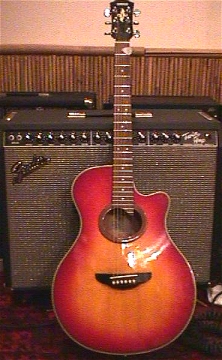 .
.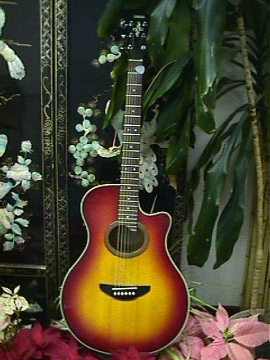 .
.